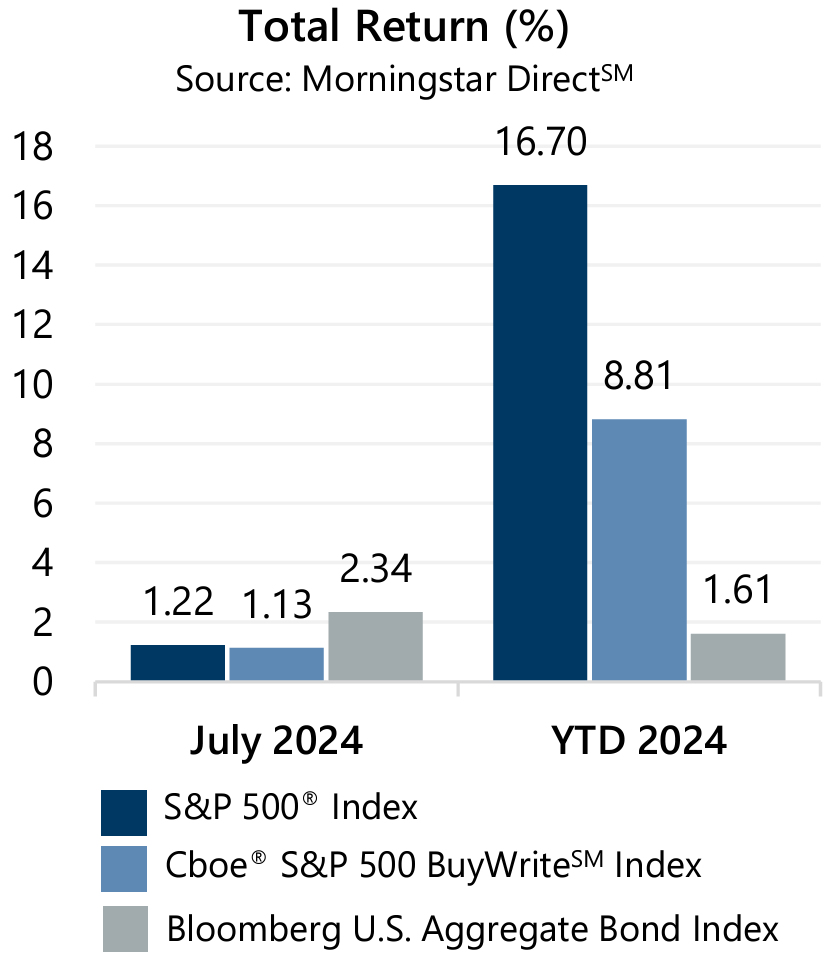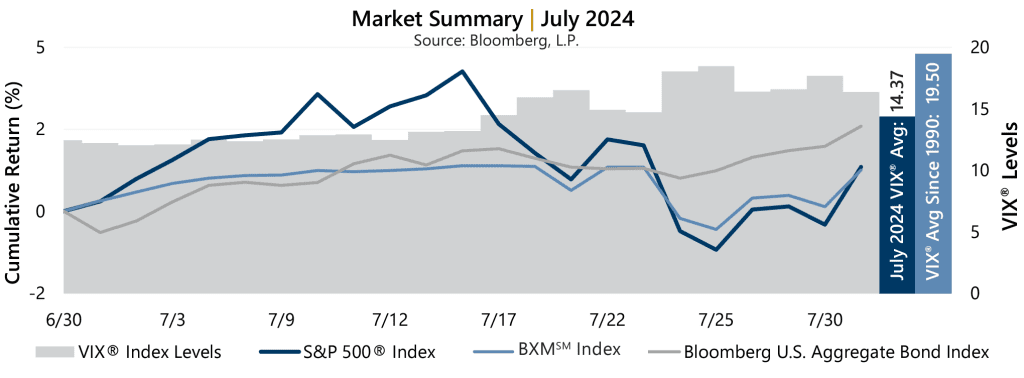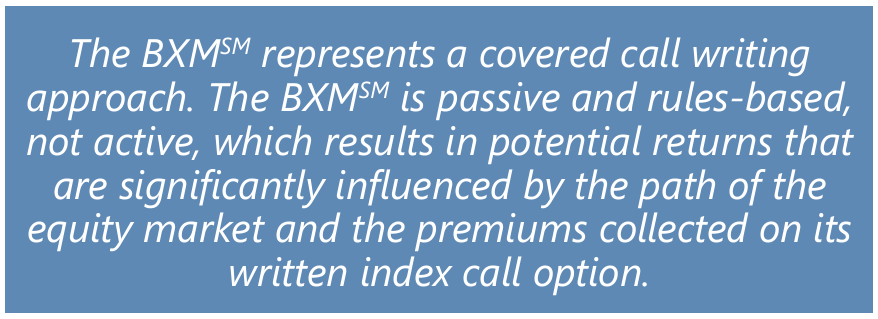 The equity market made it to the finish line in positive territory after a volatile month with a return of 1.22%. As a potential interest rate cut in September 2024 comes into focus, the S&P 500® Index started the month strong with a 3.84% advance from the end of June through July 16 – reaching a new all-time high. Poor technology-related earnings, however, contributed to a -4.71% equity market decline from July 16 through July 25. As the U.S. Federal Reserve (the Fed) appeared to set the stage for a third-quarter 2024 rate cut, the S&P 500® Index rallied 2.30% from July 25 to month-end. From the start of 2024 through July 31, the S&P 500® Index has climbed 16.70%.
The equity market made it to the finish line in positive territory after a volatile month with a return of 1.22%. As a potential interest rate cut in September 2024 comes into focus, the S&P 500® Index started the month strong with a 3.84% advance from the end of June through July 16 – reaching a new all-time high. Poor technology-related earnings, however, contributed to a -4.71% equity market decline from July 16 through July 25. As the U.S. Federal Reserve (the Fed) appeared to set the stage for a third-quarter 2024 rate cut, the S&P 500® Index rallied 2.30% from July 25 to month-end. From the start of 2024 through July 31, the S&P 500® Index has climbed 16.70%.
Data released in July showed a resilient macroeconomic backdrop with a slightly softening labor market and progress on inflation, setting the stage for the first potential rate cut of 2024. The first estimate of Gross Domestic Product for the second quarter of 2024 beat the consensus estimate and exceeded the prior quarter. The year-over-year June Consumer Price Index, released July 11, was lower than the previous reading and below consensus estimates. The quarter-over-quarter Personal Consumption Expenditures (PCE) Price Index, the Fed favorite, also showed a decline from the prior period but above the consensus expectation. Corporate earnings showed some volatility, with second quarter aggregate operating earnings on track to climb 0.7% quarter-over-quarter and 4.4% year-over-year. With just over 61% of S&P 500® Index companies reporting, nearly 85% have met or exceeded analyst estimates.

Implied volatility, as measured by the Cboe® Volatility Index (the VIX®), averaged 14.37 in July. Realized volatility, as measured by the standard deviation of daily returns for the S&P 500® Index, was 14.48% for the month. In a turnabout of the typical relationship, and for the first time since November 2022, realized volatility exceeded implied volatility. In June, S&P 500® Index realized volatility reached its lowest level since November 2019 before significantly normalizing in July towards a since-1990 average of 15.44%. The spread between S&P 500® Index implied and realized volatility, or the Volatility Risk Premium was -11 basis points (bps) in July compared to the long-term average of +406 bps. The VIX® ended June at 12.44 and reached a July low of 12.03 on July 2. As the market declined, the VIX® climbed to an intra-month high of 18.46 on July 25. The VIX® closed the month at 16.36.

 The Cboe® S&P 500 BuyWriteSM Index1 (the BXMSM) returned 1.13% in July, bringing its year-to-date return to 8.81%. The premiums the BXMSM collected as a percentage of its underlying value provided loss mitigation and are an important component of performance. The passive approach of the BXMSM resulted in relatively low market exposure when entering July, which was reset when the BXMSM wrote its new index call option with an August expiration. From the close of June to July 16, the BXMSM returned 1.25% while the S&P 500® Index climbed 3.84%. The BXMSM collected a premium of 1.53% when writing its new index option on July 19, which supported returns through the remainder of the month and offered downside protection. During the market’s drawdown from July 16 to July 25, the BXMSM returned -1.72% compared to the S&P 500® Index decline of -4.71%.
The Cboe® S&P 500 BuyWriteSM Index1 (the BXMSM) returned 1.13% in July, bringing its year-to-date return to 8.81%. The premiums the BXMSM collected as a percentage of its underlying value provided loss mitigation and are an important component of performance. The passive approach of the BXMSM resulted in relatively low market exposure when entering July, which was reset when the BXMSM wrote its new index call option with an August expiration. From the close of June to July 16, the BXMSM returned 1.25% while the S&P 500® Index climbed 3.84%. The BXMSM collected a premium of 1.53% when writing its new index option on July 19, which supported returns through the remainder of the month and offered downside protection. During the market’s drawdown from July 16 to July 25, the BXMSM returned -1.72% compared to the S&P 500® Index decline of -4.71%.
The Bloomberg U.S. Aggregate Bond Index returned 2.34% in July, bringing its year-to-date return to 1.61%. The yield on the 10-year U.S. Treasury Note (the 10-year) ended June at 4.40% and reached its intra-month high of 4.46% on July 1. The 10-year fell throughout the month, closing July at an intra-month low of 4.03%. In a historical inversion that has persisted since July 5, 2022, the yield on the 2-year U.S. Treasury Note exceeded that of the 10-year for the month.
1The BXMSM is a passive total return index designed to track the performance of a hypothetical buy-write strategy on the S&P 500® Index. The construction methodology of the index includes buying an equity portfolio replicating the holdings of the S&P 500® Index and selling a single one-month S&P 500® Index call option with a strike price approximately at-the-money each month on the third Friday of the standard index-option expiration cycle and holding that position until the next expiration.
Sources: Morningstar DirectSM, Bloomberg, L.P. Performance data shown represents past performance and is no guarantee of, and not necessarily indicative of, future results.
For more information and access to additional insights from Gateway Investment Advisers, LLC, please visit www.gia.com.


